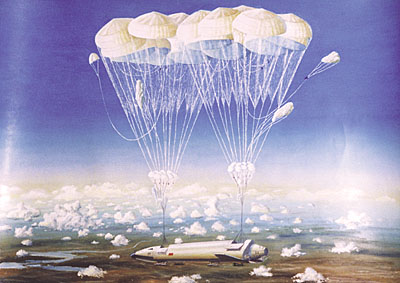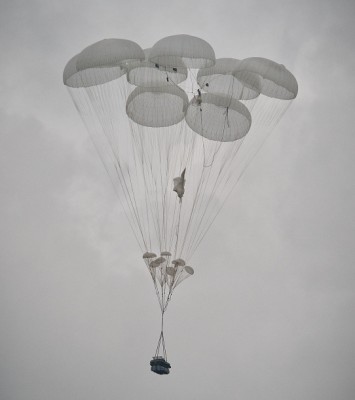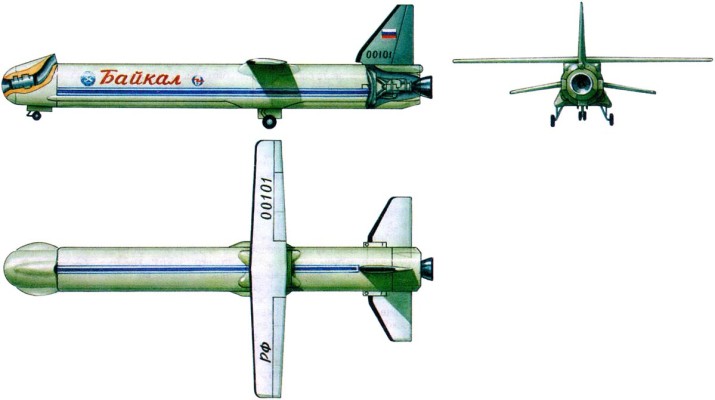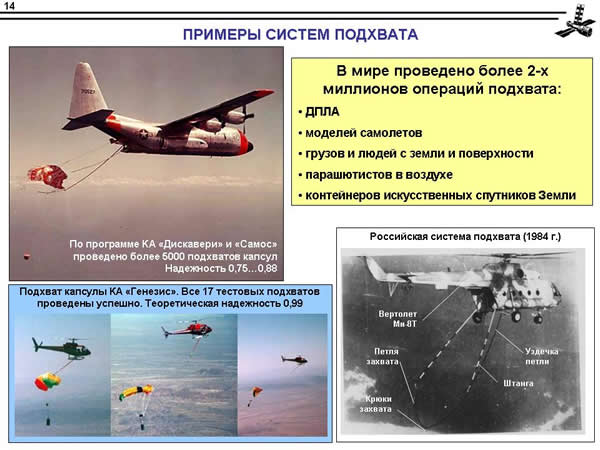Soft landing system for the first stage of the launch vehicle

People who are interested in technology and astronautics look with great interest at the tests of the "Grasshopper" Mask, which, as we are promised, will grow into a full-fledged return stage. In this article I will try to talk about what other systems for providing a soft fit for the carrier were invented by humanity, and also give an approximate assessment of the weighted perfection of these systems.
Introduction And why do they invent it?
Liquid fuel is a cheap thing compared to a booster rocket. Therefore, the idea of saving the spent stage for its re-use of the vital in the air was still at the dawn of rocket production. However, despite many ideas and projects, only the Space Shuttle solid-fuel boosters were the only serial reusable first stage. This is not surprising, because any landing system requires additional weight, which is very expensive in rocket production.
Reusable falcon

The ideal of the system is complete reusability, as in the famous video . To ensure a soft landing sustained engines are selected, which, despite some unusual, took place in history. The Zorya of Feoktistov was supposed to get on the engines, a demonstrator of the DC-X technology flew in the West. Let's try to calculate the proportion of the landing system:
1. It is necessary to calculate the speed of the first stage of the Falcon 9, which is in a free fall, i.e. what is the initial speed you need to slow down? Here is a calculation using WolframAlpha .
Initial data:
The initial height is 50 km. The figure is approximate, taken from the assumption in this discussion .
The air density is 1.2 kg / m ^ 3, the table data from Wikipedia for a temperature of 20 degrees Celsius.
Weight - 20 tons. The estimated mass of the first stage is taken from here .
The form drag coefficient is 0.82 for a long cylinder, tabular .
Projection area - 42 m ^ 2, obtained by the formula area from a known radius .
Result: 260 m / s.
Note: the real figure will be somewhat higher, because this formula considers the initial speed to be zero, and, instead of approximating "from above" for an initial zero speed, in this case it is approximating "from below" because the rocket will slow down with a higher initial speed .
2. Calculate the required fuel stock for braking from 260 m / s to zero using the Tsiolkovsky formula. Calculation on WolframAlpha .
Initial data:
Specific impulse: 2600 m / s, data for Merlin 1C .
Result: 2 tons of fuel must be spent on braking. This is the lower ideal estimate, because we do not take into account the gravitational losses and control losses. If we take the estimated share of gravitational losses from here , then the fuel supply will increase to at least three tons, and, taking into account management losses, may exceed four tons.
3. Add a lot of landing supports. In open sources, their weight is indicated in 2 tons.
Bottom line : a minimum of 6 tons must be added to a twenty ton rocket for its landing using this method, which gives us approximately a 30% share of the means of providing a soft landing to the dry weight of the stage.
PS Information about the intention to return to the launch site on the engines looks very strange, because then the required supply of fuel will increase several times.
')
Parachutes

With the development of synthetic fabrics, parachutes are becoming easier and potentially more attractive for the return of space technology. For example, the PBS-950 landing system already used in the Airborne Forces has a payload mass of 13 tons and an airborne supply share of 11.6% . That is, a parachute system with air bags for a twenty ton rocket will fit in 2-3 tons! The most noticeable disadvantage is that the system is uncontrolled and a landing zone will be required for landing.
Rogallo's Wing
In the 60s, NASA conducted research on the Rogallo wing that was being deployed in flight to provide a controlled landing of the Gemini spacecraft and rescue the first stage of the Saturn-I rocket. Video tests of full-scale model 1:12 steps:
You can also see tests of the wing with rigid elements and tests of the wing without rigid elements .
The only figures that I managed to find here say that such a wing occupied 20% of the weight of the step model. Given the progress in materials science, which led to the rise of paragliding, one can hope that a controlled wing without rigid elements would fit in 10-15% of the weight of the step.
Hard wing

During the development of the LV "Energy", there appeared projects of reusable first stages with rigid wings. This idea reached its apex in the Energy-2 project with a reusable central unit of cyclopean size. And after the collapse of the USSR, the lighter project “Baikal” appeared . Unfortunately, it cannot be directly compared with other systems, because it is a full-fledged aircraft with an engine and fuel to ensure a return distance of 400 km and landing on an airfield not far from the launch site. Theoretically, the system is advantageous in that the overclocking units can be launched with any inclination, and they will be returned, which should eliminate the need for the exclusion zones. But, I am afraid, the proportion of additional weight to ensure reusability will be greatest here. For comparison, the Angara’s URM , which has approximately the same total mass , has half the empty mass, and the first stage, the Falcon 9, which has approximately the same empty mass, has twice the total mass.
Helicopter pickup

When lowering with parachute, this stage can not be dropped to the ground, spending additional weight on shock absorption systems, but can be caught by a helicopter, which will then provide a guaranteed soft landing in the right place. You can also save weight by reducing the area of parachutes, because increasing the speed of descent does not make it difficult to absorb shock. That is, you can achieve a proportion of the weight of landing systems <10% ! The most heavy-duty of the serial helicopter Mi-26 can lift 20 tons, which is enough butt. Curiously, there is an article stating that helicopter pick-up experiments were conducted in the 1990s and were successful .
Conclusion
If we sort the listed systems by the specific gravity of the landing support systems, helicopter pickup and parachutes will be in the first place, and the landing on rocket engines will be the last or the last but one. What attracts even more interest in the Mask project - what will be there in the end?
For navigation: posts on the tag "Facilitation of access to space"
Source: https://habr.com/ru/post/193810/
All Articles